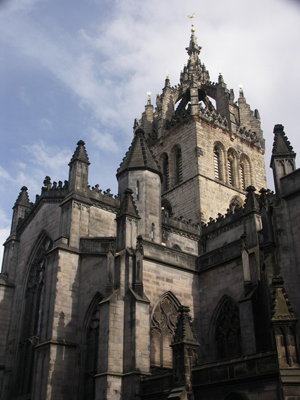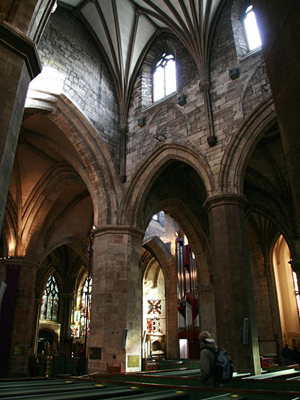| |
 |
 |
 |
| Comment on this report, or find other reports. |
 |
| Our Mystery Worshippers are volunteers who warm church pews for us around the world. If you'd like to become a Mystery Worshipper, start here. |
 |
| Find out how to reproduce this report in your church magazine or website. |
|
|
| 1606: St Giles'
Cathedral, Edinburgh, Scotland |
 |

Photo: Titanic |
 |
Mystery Worshipper:
Diapason.
The church:
St
Giles' Cathedral, Edinburgh, Scotland.
Denomination:
Church
of Scotland.
The building:
A prominent feature of the Edinburgh skyline, St Giles is also
known as the High Kirk of Edinburgh. Its origins go back to
a simple parish church built in 1130. Over the years that simple
building, which probably started as merely a nave, acquired
a chancel and aisles along each side, plus transepts and a tower
over the crossing. Around 1500 the tower was heightened and
a stone crown added to its top, thus forming the highly distinctive
hollow-crown landmark that we know today. By 1581 the building
housed three different Reformed congregations, and internal
walls were built to separate the areas they used. St Giles has
been called a cathedral since 1635, when William Forbes became
the first Scottish Episcopal bishop of the new diocese of Edinburgh,
with St Giles as his seat. By 1800 the cathedral was in a poor
state of repair. It was now divided into four churches, plus
a meeting house for the general assembly, a police office, and
a fire engine house! Between 1871 and 1883, major restoration
of the interior removed the internal walls and returned the
space to the more unified (if still complex) plan we see today.
Renovations continued throughout the 20th century, including
the addition of a chapel for the Knights of the Thistle. Seating
is arranged around the holy table, with some box pews but mainly
loose seating. Seats in the old chancel area face west rather
than east. In the south transept facing north toward the sanctuary
is a choir area.
The church:
St Giles is sometimes regarded as the mother church of Presbyterianism,
and has been one of Edinburgh's religious focal points for approximately
a thousand years. It is the Church of Scotland parish church
for part of Edinburgh's Old Town. Five services are held every
Sunday, as well as daily services and special services for state
and civic occasions. St Giles' senior minister, the Very Revd
Gilleasbuig Macmillan, has held that post since 1973, and is
also dean of the Thistle and a chaplain-in-ordinary to Her Majesty
The Queen.
The neighbourhood:
St Giles lies on the Royal Mile Edinburgh, about two thirds
the way up from the palace of Holyroodhouse and the castle.
The Royal Mile is the popular name for the streets that form
the main thoroughfare of the Old Town. Around the cathedral
are a wide variety of shops, pubs and restaurants. Fronting
the west end of the building are the old Parliament House and
the Registry office.
The cast:
The Revd Dr Hilary Smith, assistant minister, led the service.
The preacher was the Revd Dr Paul Middleton, who was visiting
from the University of Wales Lampeter. Peter Backhouse, the
cathedral's assistant organist, and Wayne Weaver, organ scholar
in residence, both presided at the organ.
The date & time:
Sunday, 31 August 2008, 11.00am.
What was the name of the service?
Morning worship with choir and sermon.
How full was the building?
Difficult to tell. St Giles could seat hundreds of worshippers,
but I'd say 150 or so were in attendance.
Did anyone welcome you personally?
A sidesperson smiled and asked if I was there for the service
– as there were some tourists mulling about! The lady I was
sitting next to in the pew gave me a hearty handshake and said,
"Nice to see you today."
Was your pew comfortable?
Traditional box pew with cushion – adequately padded!
How would you describe the pre-service
atmosphere?
Very quiet and austere – a surprise given all the bustle with
tourists at the main door. The organist played voluntaries by
Stanley and Handel.
What were the exact opening
words of the service?
The cathedral choir sang the anthem Holy is the True Light
by Michael Harris, the cathedral's head organist and master
of the music. Then the Revd Dr Smith said, "Good morning and
welcome to St Giles."
What books did the congregation
use during the service?
Church Hymnary, Third Edition (CH3) and standard Church
of Scotland service sheet.
What musical instruments
were played?
Pipe organ, an instrument built in 1992 by the Austrian firm
of Rieger Orgelbau incorporating two pedal stops from the previous
organ.
Did anything distract
you?
The bustle of tourists. They were asked to respect the service
that was in progress, but they still mulled about.
Was the worship stiff-upper-lip,
happy clappy, or what?
Very stiff upper lip as you'd expect from St Giles' Cathedral.
It was very reverent, if not a bit staged, but took a natural
progression. The service followed a traditional order, with
collect, preces, and sung psalm and anthem.

Photo: photojenni
Exactly how long was the
sermon?
15 minutes – seemed longer!
On a scale of 1-10, how
good was the preacher?
5 – The Revd Dr Middleton tried to start with a joke, but
it was wasted on those who had not been present at the 10.00am
holy communion service. His sermon was very lecture-like (he
is, after all, a university lecturer). He kept moving away from
the fixed microphone, which was rather annoying.
In a nutshell, what was
the sermon about?
He started off explaining how the revised common lectionary
is set for use in all churches if they want, and how it is hoped
that the whole church will be reading the same texts, thus creating
a unity approach. After that he lost me!
Which part of the service was like being in
heaven?
The choir was heavenly – their sung psalm and anthem were divine.
And which part was like being in... er... the other place?
At the beginning of the service, the choir and clergy processed
in, singing the hymn "My God, how wonderful thou art"
(to the tune of Westminster). The choir walked around the nave
and then down the aisle to the choir stalls. As their distance
from the organ varied, they became more and more out of sync
with the organ, to say nothing of the congregation! With everyone
all at sixes and sevens, I ended up being the only person singing
in my pew!
What happened when you hung around after the service looking lost?
The general direction of the people flow was out the main door,
so I followed suit.
How would you describe the after-service
coffee?
It was announced that the lower aisle restaurant was open for
light lunch and snacks after the service.
How would you feel about
making this church your regular (where 10 = ecstatic, 0 = terminal)?
5 – A service such as this, steeped in history with a full
musical treatment, is fantastic. The sermon lost me, though.
I'd like to go back to hear the cathedral's regular clergy preach.
But based on today, I'd just go back for the music!
Did the service make you
feel glad to be a Christian?
Yes. It was a very reverent service and had some very tender
moments, especially with the music you would expect to hear
in a cathedral.
What one thing will you remember about all this in seven days' time?
The moving choir! |
|
|
 |
 |
 |
| We rely on voluntary donations to stay online. If you're a regular visitor to Ship of Fools, please consider supporting us. |
 |
 |
 |
| The Mystery Pilgrim |
 |
| One of our most seasoned reporters makes the Camino pilgrimage to Santiago de Compostela in Spain. Read here. |
 |
 |
 |
| London churches |
 |
| Read reports from 70 London churches, visited by a small army of Mystery Worshippers on one single Sunday. Read here. |
| |
|
|
|
|


